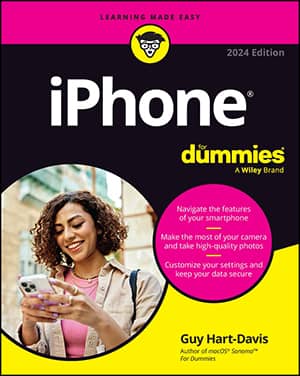Apple's iCloud service is more than just a wireless hard drive in the sky. iCloud is a complete wireless storage and data synchronization solution. In a nutshell, iCloud is designed to store and manage your digital stuff — your music, photos, contacts, events, and more — keeping everything updated on all your computers and iDevices automatically with no physical (wired) connection or action on your part. Like so many things Apple makes, iCloud (usually) just works.
Basics of iCloud
iCloud pushes information such as e-mail, calendars, contacts, and bookmarks to and from your computer and to and from your iPhone and other iDevices, and then keeps those items updated on all devices wirelessly and without human intervention. iCloud also includes nonsynchronizing options, such as Photo Stream and e-mail.
Your free iCloud account includes 5GB of free storage, which is all many (if not most) users will need. If you have several devices (including Macs and PCs) or like saving data in the cloud, you'll probably find yourself needing more storage; 10-, 20-, and 50-gigabyte upgrades are available for $20, $40, and $100 a year, respectively.
A nice touch is that music, apps, iBooks (but not audiobooks, which do count against your 5GB), periodicals, movies, and TV shows purchased from the iTunes Store, as well as your Photo Stream and iTunes Match content, don't count against your 5GB of free storage.
You'll find that the things that do count — such as mail, documents, photos taken with your iPhone camera, account information, settings, and other app data — don't use much space, so that 5GB should last you a long time. (Remember to sync photos you take with the iPhone every so often or they will, over time, start eating up a lot of space.)
How to sync iCloud with your iPhone
Enable iCloud syncing on your iPhone if you plan to go PC-free but still want to have your e-mail, calendars, contacts, and bookmarks synchronized automatically and wirelessly between computers and iDevices.
Here's how to activate iCloud syncing on your iPhone:
Tap Settings on your Home screen.
Tap iCloud in the list of settings on the left.
Tap Account and provide your Apple ID and password (if you haven't provided it previously).
Tap Done.
Now tap any of the individual On/Off switches to enable or disable iCloud sync for any of the following options:
Mail
Contacts
Calendars
Reminders
Bookmarks
Notes
Passbook
Photos
Documents & Data
Find My iPhone
Tap Storage & Backup near the bottom of the screen to manage your iCloud storage, enable or disable iCloud backups, upgrade your storage plan, or initiate a backup to iCloud right now.

